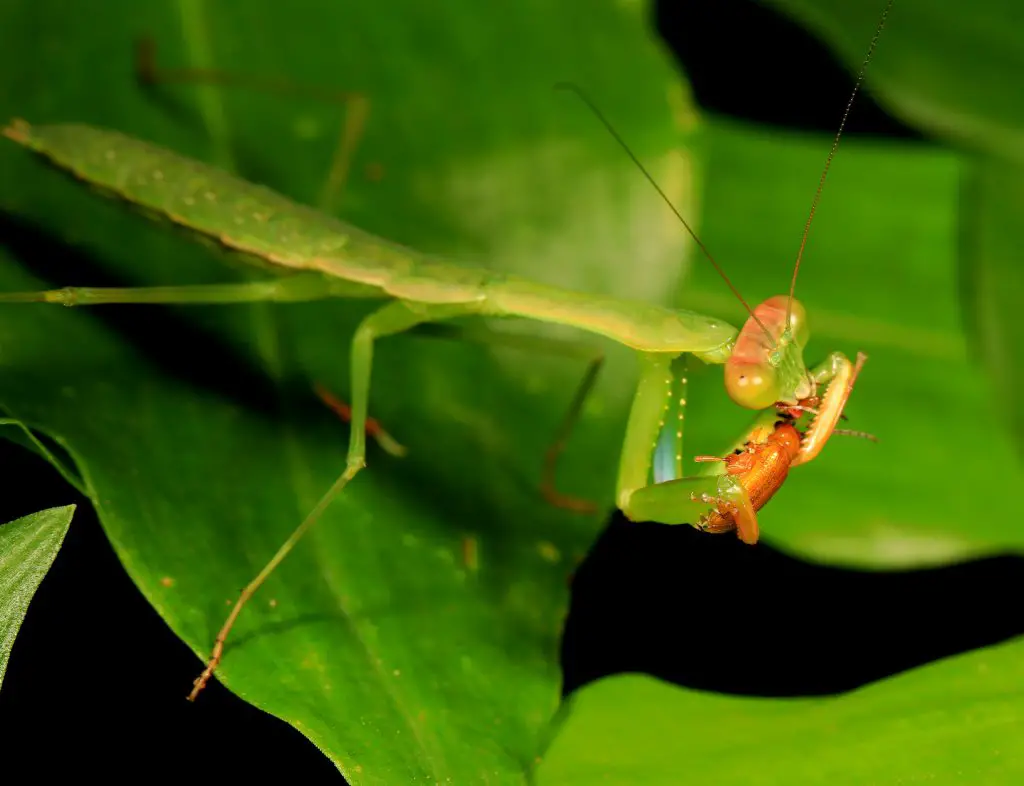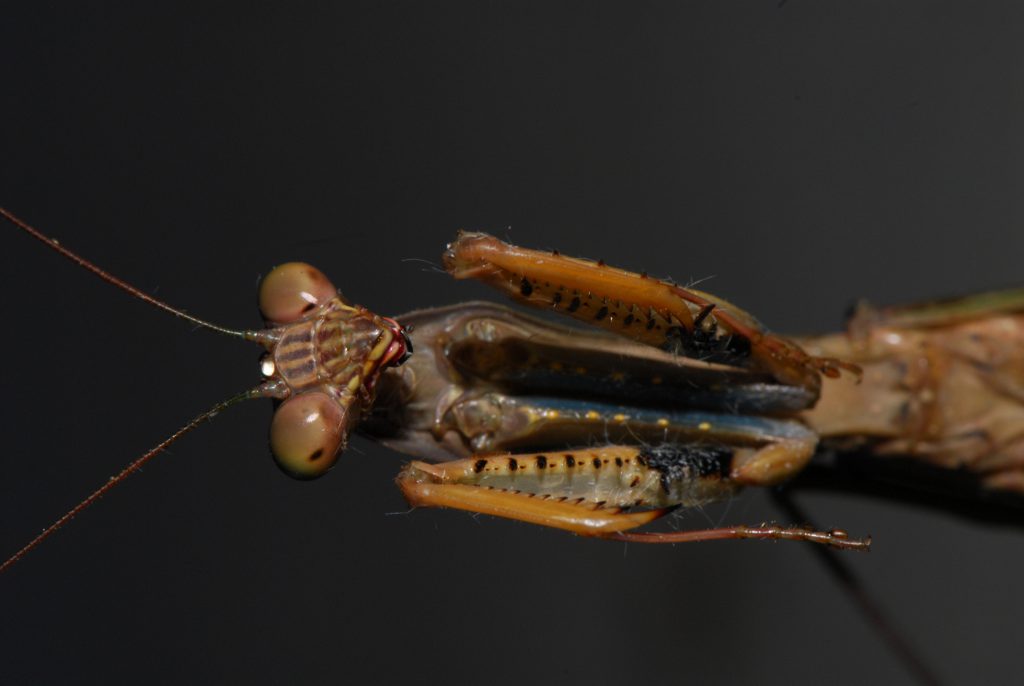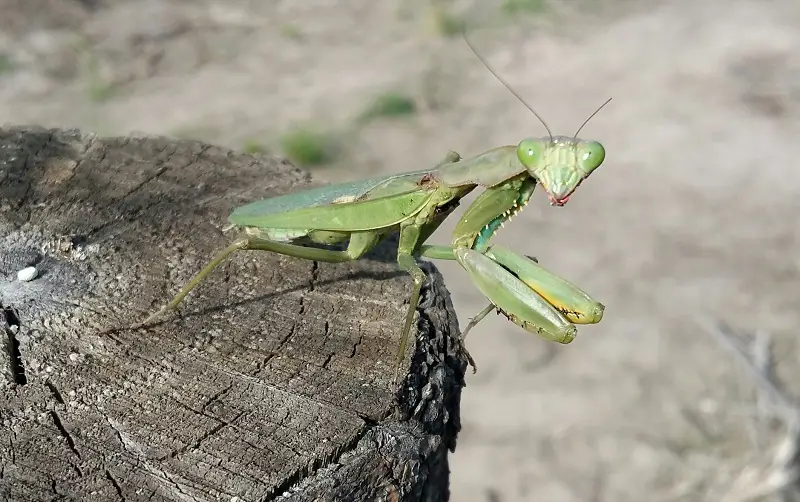When it comes to the realm of mantises, few species capture the imagination quite like the Madagascan Marble Mantis (Polyspilota aeruginosa). This striking insect, belonging to the Polyspilota genus, stands tall and proud in the mantis world, showcasing a slim yet commanding physique that beckons attention.
- Description
- Sexing Madagascan Marble Mantis
- Ideal Keeping Conditions
- The Art of Breeding Madagascan Marble Mantises
- The Prelude to Passion: Copulation Readiness
- A Dance of Intimacy: Copulation
- The Genesis of Life: Ooth Building
- Awaiting New Beginnings: Ooth Hatching
- Precious Ooths: Quantity, Size, and Appearance
- The Incubation Journey: Temperature and Humidity
- The Moment of Arrival: Ooth Hatching
- Welcoming the Next Generation: Hatching Appearance
- Sustaining the Breeding Environment
- Conclusion

Description
A Slim and Tall Marvel
Polyspilota is a genus that embodies elegance and charm. Its members possess a slender physique that sets them apart from the crowd of mantises. One of the genus’s defining features is the captivating display of colorful spots on their wings and arms. This unique adornment adds a touch of artistic flair to their already impressive stature.
Venturing into the world of Polyspilota aeruginosa reveals a true gem among mantis species. The Madagascan Marble Mantis is a vibrant example of the genus’s diversity. With a mix of captivating colors and intricate patterns, this mantis showcases its beauty with pride.
The Enigmatic Behavior
One cannot discuss Polyspilota without delving into their captivating behavior. The genus is known for its remarkable threatening display, a spectacle that leaves an indelible mark on anyone lucky enough to witness it. This behavior is a testament to their fierce nature, a quality that characterizes the entire Polyspilota family.
Where to Find Them
Inhabiting the warm and dry territories of bushes, trees, and sparse vegetated areas, Polyspilota mantises truly embrace the essence of their chosen habitats. These creatures are masters of adaptation, thriving in environments that might seem challenging to other species. Their resilience and adaptability are a testament to the wonders of the natural world.
A Kaleidoscope of Variants
Diversity reigns supreme in the world of Polyspilota. With a variety of color variants at their disposal, these mantises are a feast for the eyes. From shades of green and brown to partial hints of yellow and rose, their colors mirror the kaleidoscope of nature itself. The wings of Polyspilota aeruginosa are a canvas of vibrant greens, bordered by striking black spots that add an alluring contrast to their appearance.
Nymphs with No Pretense
Even in their earlier stages, the nymphs of Polyspilota stand out from the crowd. While exhibiting the appearance of larger nymphs, they lack the mimicry that some species rely on. This straightforward approach to their appearance is a testament to their uniqueness and their confidence in their true selves.
Delving into Taxonomy
To truly appreciate the magnificence of the Madagascan Marble Mantis, it’s important to understand its taxonomy. This species belongs to the Dictyoptera super-order, which places it firmly within the Mantodea order. Within the family Mantidae, it finds its home in the subfamily Mantinae. The species is further classified under the Mantini tribe, a fitting categorization for a mantis of such distinction.
First Steps in Discovery
The journey of Polyspilota aeruginosa in the annals of scientific exploration began in 1778 when it was first described by the renowned author Johann August Ephraim Goeze. His keen observations and meticulous documentation laid the foundation for our understanding of this captivating species.
The Splendor of Africa
Polyspilota aeruginosa is not just a mantis; it’s a representation of a continent’s natural splendor. This species spreads its wings across the captivating landscapes of Africa. From bushes to trees, from sun-exposed areas to the secluded corners of sparse vegetation, this mantis claims its territory with confidence and grace.
A Show of Aggression
Aggressiveness is the hallmark of Polyspilota aeruginosa. This mantis boasts a high level of aggression when it comes to prey and interactions with other mantises. This trait is a reflection of its survival instincts, honed by generations of adapting to the challenges of its environment.
The Artistry of Color
Polyspilota aeruginosa is a canvas of creativity when it comes to color. Its variability knows no bounds, with shades ranging from basic greens and browns to enchanting hints of yellow and rose. The wings of this mantis are a masterpiece, showcasing vigorous green borders that encircle a rich center of brown. A black spot, a subtle yet captivating detail, graces the inside of its arms, adding an unexpected touch of mystique.
Sexing Madagascan Marble Mantis
Size and Lifespan
Size matters, and when it comes to Polyspilota mantises, it’s one of the key differentiators between males and females. The males hold their own at a size range of approximately 8cm to 9cm, while their female counterparts maintain a stature of around 8cm. This subtle distinction is a starting point in unraveling the enigma of sexing these mantises.
Lifespan adds another layer of intrigue to the mantis tale. Males boast a lifespan of approximately 8 months, a journey that encompasses both their nymph and adult phases. Throughout this time, they undergo approximately 8 moltings, a testament to the changes they undergo as they mature. On the other hand, females take a slightly different path, with a lifespan of about 13 months that includes around 9 moltings. This extended journey contributes to the fascinating saga of their lives.
Male Sexing
For those eager to unravel the mysteries of mantis gender, the males of Polyspilota aeruginosa hold some revealing clues. Starting from the L5 stage and beyond, a few key characteristics come into play. Thick antennas and the presence of 8 abdominal segments are distinctive traits that set the males apart. These characteristics provide a glimpse into the gender identity of these mantises even before they reach full maturity.
As they transition into adulthood, the male mantises continue to display characteristics that help distinguish them from their female counterparts. Adult males are generally smaller than females, but their vivid colors compensate for their size. The wings of males extend past the abdomen, creating a striking visual contrast. This difference in wing length becomes a reliable marker in the art of identifying male Polyspilota aeruginosa.
Female Sexing
Unraveling the gender code of Polyspilota aeruginosa females requires a keen eye and an appreciation for subtlety. From the L5 stage onwards, a simple method of counting the abdominal segments becomes the key to determining a female’s gender. Females proudly bear 6 abdominal segments at this stage, a characteristic that sets them apart and offers a clear indicator of their sex.
As the females mature into adulthood, their physical traits become even more pronounced. Adult females exhibit a more compact physique compared to their male counterparts. Their wings, a defining feature, elegantly cover the entirety of the abdomen. This distinct difference in wing coverage becomes a reliable guide in identifying the enchanting females of this species.
A Quick Guide to Gender Identification
To sum it up, gender identification among Polyspilota aeruginosa mantises can be approached with the following traits:
Male Traits:
- Thick antennas from L5 stage and above
- 8 abdominal segments from L5 stage and above
- Smaller size (especially as adults)
- Vibrant colors
- Longer wings that extend beyond the abdomen
Female Traits:
- 6 abdominal segments from L5 stage and above
- More compact body
- Wings that elegantly cover the abdomen

Ideal Keeping Conditions
When it comes to providing a thriving habitat for the captivating Madagascan Marble Mantis (Polyspilota aeruginosa), striking a balance between comfort and authenticity is the key to success. Let’s explore the nuances of light, temperature, humidity, enclosure size, and more, as we craft the ultimate environment for these remarkable creatures.
Let There Be Light
In the world of mantises, light plays a vital role in maintaining their well-being. For the Madagascan Marble Mantis, natural daylight is a sufficient source of illumination. However, to create a comfortable and visually appealing environment, it’s recommended to supplement natural light with options like halogen lamps. This not only ensures their comfort but also highlights their vibrant colors and unique features.
When it comes to light, timing matters. Offering your mantises around 12 hours of light per day mimics their natural environment, creating a healthy day-night cycle that supports their activities and rest.
Temperature Comfort Zone
Maintaining the right temperature is paramount in ensuring the well-being of your mantises. During the day, keep the temperature within the range of 25°C to 35°C to provide them with a warm and comfortable atmosphere. When the sun sets, make sure the temperature doesn’t drop below 20°C to safeguard them from cold stress.
The Art of Humidity
Humidity is another critical factor in creating an environment where Madagascan Marble Mantises can flourish. During the day, aim for a humidity level of 50% to 60%, allowing them to thrive without becoming too damp. As night falls, gently raise the humidity to a range of 60% to 70%, providing a cozy atmosphere for their nocturnal activities. Remember to lightly spray the enclosure every 2 to 3 days to maintain the optimal humidity level.
Size Matters: Terrarium Dimensions
When crafting the perfect home for your mantises, consider the dimensions of the enclosure. For single keeping, ensure that the terrarium is at least 20cm x 20cm x 30cm. This provides ample space for them to move, explore, and molt comfortably. However, community keeping is not recommended for Madagascan Marble Mantises, as their natural aggressiveness may lead to conflicts.
A crucial detail in their terrarium design is providing ample space for safe molting. Ensuring that there’s something at the top of the enclosure, such as a window screen mesh, offers your mantises a secure place to hang from during this vulnerable phase of their lives.
The Ground Beneath Their Feet
Terrarium substrate is an often overlooked but essential element. A mixture of pulp and earth-sand provides a suitable substrate that aids in maintaining the appropriate humidity levels while offering a comfortable surface for your mantises to traverse.
A Nutritious Menu
The Madagascan Marble Mantis has a discerning palate. Preferred foods include drosophila, flies, moths, crickets, and grasshoppers. These sources of nourishment are not only a feast for your mantises but also provide the essential nutrients they need to thrive.
Creating the perfect haven for your Madagascan Marble Mantises involves a delicate balance of temperature, humidity, and creature comforts. By paying attention to these nuances, you’ll be offering them a thriving environment that echoes their natural habitat and allows them to exhibit their enchanting behaviors.
The Art of Breeding Madagascan Marble Mantises
From the dance of copulation readiness to the delicate task of ooth creation and hatching, every step in this process is a celebration of nature’s intricacy. Let’s explore the stages of breeding these remarkable creatures and unlock the secrets of nurturing the next generation.
The Prelude to Passion: Copulation Readiness
The dance of romance begins with timing. For males, copulation readiness arrives approximately 2 weeks after their last molt. On the other hand, females take their time, becoming receptive around 4 weeks after their last molt. This careful synchronization sets the stage for a harmonious encounter.
A Dance of Intimacy: Copulation
When the moment of copulation arrives, time takes on a new dimension. Mating sessions for Madagascan Marble Mantises typically span from 9 to 15 hours, a testament to the thoroughness of their courtship. This extended duration ensures a successful exchange of genetic material, a crucial step in the cycle of life.
The Genesis of Life: Ooth Building
Following the delicate dance of copulation, the females of Polyspilota aeruginosa begin a new phase: ooth creation. Within 2 to 3 weeks after copulation, the first ooth is formed. These egg cases are a marvel of nature, encapsulating the potential for new life.
Awaiting New Beginnings: Ooth Hatching
The journey from ooth creation to hatching is a waiting game filled with anticipation. Ooths hatch within 2 to 4 weeks of being laid. The incubation period is a time of patience and care, as the conditions within the ooth foster the development of the next generation.
Precious Ooths: Quantity, Size, and Appearance
Each female Polyspilota aeruginosa has the potential to lay up to 5 ooths during her lifetime. These ooths exhibit a size range of 2cm to 3cm and come in the shapes of semicircles and ovals. Their colors vary from light brown to dark brown, mirroring the intricate palette of nature itself.
The Incubation Journey: Temperature and Humidity
Creating the optimal environment for ooth incubation is crucial. Maintaining an incubation temperature of around 25°C to 30°C ensures the delicate embryos develop as nature intended. A humidity level of 50% to 60% adds the necessary moisture, requiring a light spray every 2 to 3 days to maintain the ideal conditions.
The Moment of Arrival: Ooth Hatching
After weeks of anticipation, the ooths finally yield their treasures. The incubation period typically spans 4 to 6 weeks, culminating in the hatching of approximately 160 tiny mantises. These hatchlings measure a mere 8mm in size but bear the promise of growth and transformation.
Welcoming the Next Generation: Hatching Appearance
As the hatchlings emerge, they display a captivating appearance. Sporting light- and dark-brown stripes, they resemble their larger nymph counterparts. This intricate patterning is a testament to the artistry of nature and a reminder of the marvels that lie within the natural world.
Sustaining the Breeding Environment
To support the breeding process, maintain temperatures between 25°C to 35°C and humidity levels of 50% to 70%. A light spray every 2nd day helps maintain the humidity required for successful breeding.

Conclusion
In the vivid world of the Madagascan Marble Mantis, we’ve uncovered a tapestry of beauty and complexity. From their elegant appearance to the delicate rituals of reproduction, we’ve journeyed through their lives, habitats, and the wonders of hatching.
As we conclude this exploration, we’re reminded that nature’s intricacies are a treasure trove of awe and inspiration. The Madagascan Marble Mantis embodies the essence of life’s diversity and the artistry of adaptation. It’s a reminder that the natural world is a canvas of endless wonders, waiting to be discovered by those who dare to look closely.
If you found this article interesting, don’t hesitate to share it on social media!
May interest you
Are praying mantis poisonous?
One prevalent question that surrounds these enigmatic insects is “are praying mantis poisonous?”. In this article, we will delve into the world of praying mantises to uncover the facts behind…